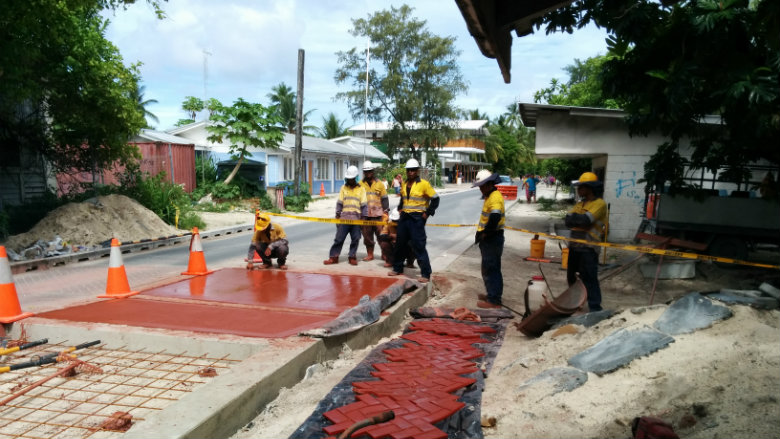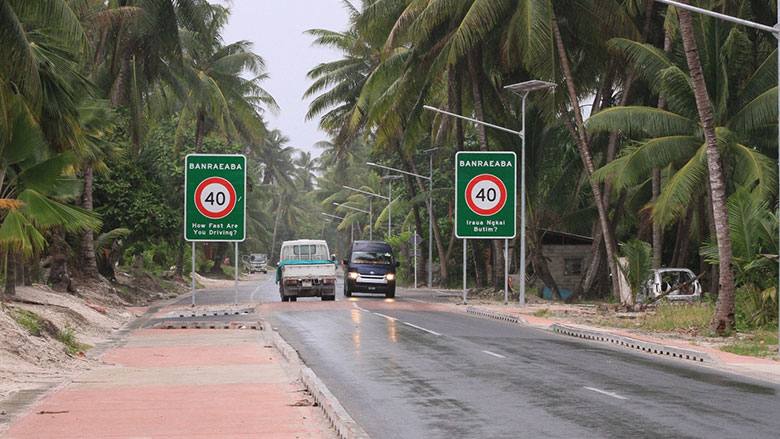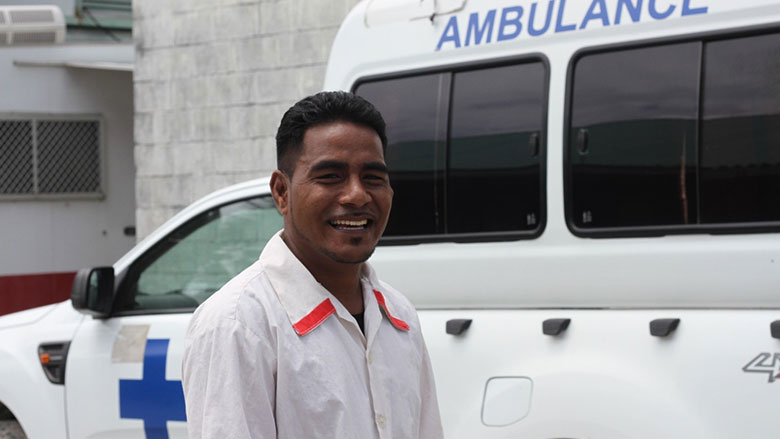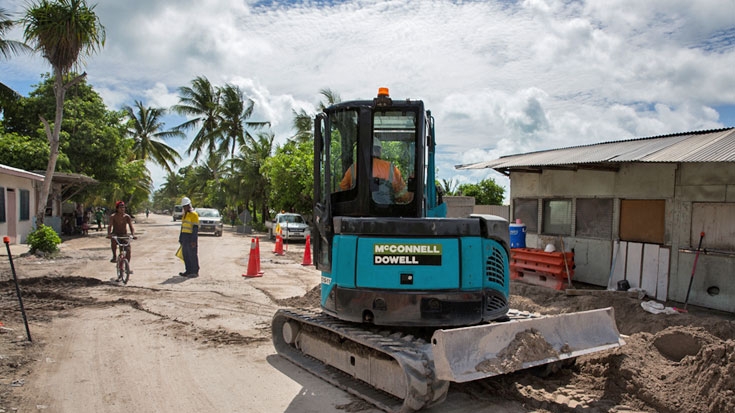Tenneke Matireei, a local ambulance driver, knows just how important having a good road is.
“My work had been tough due to the bad condition of the road, particularly when considering the comfort and urgency of each patient we transport.
“You have to drive very slow… Some patients have died on the road as we couldn’t make it to the hospital in time.”
Fixing the road brings smoother and safer rides for drivers, pedestrians and cyclists
Recognizing the urgent need to fix the road, the Government of Kiribati partnered with the World Bank, Asian Development Bank and the Government of Australia to repair the road, and prepare for its ongoing maintenance.
The Kiribati Road Rehabilitation Project has now rehabilitated over 32 kilometers of the South Tarawa Road, and upgraded six kilometers of feeder roads. Footpaths have been installed and pavement marking added to improve pedestrian safety; improved drainage means less flooding and damage from heavy rain; and solar street lighting, and road signage was added to increase safety.
“Kiribati is one of the most remote countries in the world and has limited local products that can be used for the roadworks,” said Oliver Whalley, joint Manager for the Kiribati Road Rehabilitation Project. “Everything, except for water, some locally sourced aggregates and sand, had to be shipped in, creating challenges in terms of cost, transport time and managing resources.”
Despite these challenges, the road is now in a much better condition.
“There is definitely a big improvement now,” said Matireei. “Before the road reconstruction it was literally impossible to drive faster than 10 kilometers an hour. But today we can carry out our service more efficiently and effectively.”
The roadworks not only provide a smoother ride for drivers, but also a safer route for pedestrians and cyclists. Fifty-seven kilometers of footpaths have been added to provide a safe space to walk and 36 bus shelters provide shelter from the rain, wind or sun, for those waiting for a bus. To promote safe driving speeds, 114 speed bumps have also been installed.
The significantly improved road conditions mean vehicles – including Matireei’s ambulance – require less frequent repairs, saving money for car owners and families.
“Today, I feel that the patients we transport feel more comfortable because the road is in a much better condition.” said Matireei. “Our fleet of ambulances will also last longer now that the road is complete, because back then they would not last a year before breaking down.”

Workers paving footpaths on the South Tarawa Road. Photo: Oliver Whalley/World Bank
Ensuring that the road will last
To keep the road in good condition going forward, the project is supporting routine maintenance through local contractors. By providing training, operational support and the purchasing of basic equipment, minor roadworks can be done by local contractors.
“We will support and train them so they can clean the drainage system, clear the roadway, fill potholes on unsealed roads, report to the Ministry of Public Works any cracks, potholes or broken edges in the pavement of sealed roads, and maintain the signage,” said Pierre Graftieaux, joint Manager for the Kiribati Road Rehabilitation Project. “These routine maintenance jobs will make the roadworks more sustainable, while at the same time reduce the cost to the government and create employment opportunities.”
Initiated in 2010, the US$60.4 million Kiribati Road Rehabilitation Project is the largest economic infrastructure investment in the country since World War II. It is funded through US$27 million from the World Bank – its first-ever International Development Association-financed investment in Kiribati – US$16.4 million from the Government of Australia, US$14.4 million from the ADB, and US$2.6 million from the Government of Kiribati.
![Image]()
Workers paving footpaths on the South Tarawa Road. Photo: Oliver Whalley/World Bank
Ensuring that the road will last
To keep the road in good condition going forward, the project is supporting routine maintenance through local contractors. By providing training, operational support and the purchasing of basic equipment, minor roadworks can be done by local contractors.
“We will support and train them so they can clean the drainage system, clear the roadway, fill potholes on unsealed roads, report to the Ministry of Public Works any cracks, potholes or broken edges in the pavement of sealed roads, and maintain the signage,” said Pierre Graftieaux, joint Manager for the Kiribati Road Rehabilitation Project. “These routine maintenance jobs will make the roadworks more sustainable, while at the same time reduce the cost to the government and create employment opportunities.”
Initiated in 2010, the US$60.4 million Kiribati Road Rehabilitation Project is the largest economic infrastructure investment in the country since World War II. It is funded through US$27 million from the World Bank – its first-ever International Development Association-financed investment in Kiribati – US$16.4 million from the Government of Australia, US$14.4 million from the ADB, and US$2.6 million from the Government of Kiribati.
![Image]()
Workers paving footpaths on the South Tarawa Road. Photo: Oliver Whalley/World Bank
Ensuring that the road will last
To keep the road in good condition going forward, the project is supporting routine maintenance through local contractors. By providing training, operational support and the purchasing of basic equipment, minor roadworks can be done by local contractors.
“We will support and train them so they can clean the drainage system, clear the roadway, fill potholes on unsealed roads, report to the Ministry of Public Works any cracks, potholes or broken edges in the pavement of sealed roads, and maintain the signage,” said Pierre Graftieaux, joint Manager for the Kiribati Road Rehabilitation Project. “These routine maintenance jobs will make the roadworks more sustainable, while at the same time reduce the cost to the government and create employment opportunities.”
Initiated in 2010, the US$60.4 million Kiribati Road Rehabilitation Project is the largest economic infrastructure investment in the country since World War II. It is funded through US$27 million from the World Bank – its first-ever International Development Association-financed investment in Kiribati – US$16.4 million from the Government of Australia, US$14.4 million from the ADB, and US$2.6 million from the Government of Kiribati.




